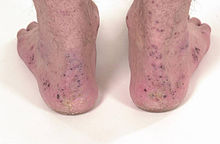Bowel-associated dermatosis–arthritis syndrome
| Bowel-associated dermatosis–arthritis syndrome | |
|---|---|
| Other names | Bowel bypass syndrome and Intestinal bypass arthritis–dermatitis syndrome |
 | |
| Pustules and crusts around the elbows in a patient with Crohn's disease and bowel-associated dermatosis-arthritis syndrome (BADAS) | |
| Specialty | Dermatology |
Bowel-associated dermatosis–arthritis syndrome (BADAS), is a complication of
An excessive
BADAS has later been reported in patients with inflammatory bowel disease,[1] diverticulitis[2] and following resection of the stomach (gastrectomy). BADAS has also been reported following
Symptoms and signs

The most typical skin changes are a red patch (
Mechanism
Immune complexes are thought to cause blood vessel damage, attracting neutrophils into the skin and synovium in BADAS.[6] These
Diagnosis
A diagnosis of this syndrome is made when an individual has the constellation of the characteristic recurrent neutrophilic dermatosis, flu-like symptoms, arthralgias or arthritis, and myalgias in the setting of a pathology of the bowels that is not best explained by another diagnosis.[citation needed]
Treatment
This section is empty. You can help by adding to it. (December 2023) |
See also
- Sweet's syndrome-like dermatosis
- List of cutaneous conditions
